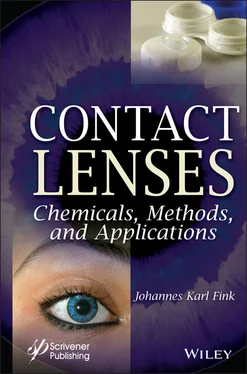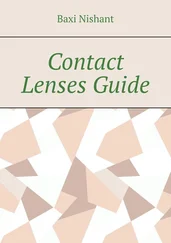Johannes Karl Fink - Contact Lenses
Здесь есть возможность читать онлайн «Johannes Karl Fink - Contact Lenses» — ознакомительный отрывок электронной книги совершенно бесплатно, а после прочтения отрывка купить полную версию. В некоторых случаях можно слушать аудио, скачать через торрент в формате fb2 и присутствует краткое содержание. Жанр: unrecognised, на английском языке. Описание произведения, (предисловие) а так же отзывы посетителей доступны на портале библиотеки ЛибКат.
- Название:Contact Lenses
- Автор:
- Жанр:
- Год:неизвестен
- ISBN:нет данных
- Рейтинг книги:3 / 5. Голосов: 1
-
Избранное:Добавить в избранное
- Отзывы:
-
Ваша оценка:
- 60
- 1
- 2
- 3
- 4
- 5
Contact Lenses: краткое содержание, описание и аннотация
Предлагаем к чтению аннотацию, описание, краткое содержание или предисловие (зависит от того, что написал сам автор книги «Contact Lenses»). Если вы не нашли необходимую информацию о книге — напишите в комментариях, мы постараемся отыскать её.
The book focuses on the chemistry and properties of contact lenses and their fabrication methods.
Audience
Contact Lenses — читать онлайн ознакомительный отрывок
Ниже представлен текст книги, разбитый по страницам. Система сохранения места последней прочитанной страницы, позволяет с удобством читать онлайн бесплатно книгу «Contact Lenses», без необходимости каждый раз заново искать на чём Вы остановились. Поставьте закладку, и сможете в любой момент перейти на страницу, на которой закончили чтение.
Интервал:
Закладка:
Table of Contents
1 Cover
2 Title Page
3 Copyright
4 Preface Acknowledgements
5 1 Types of Lenses1.1 History of Contact Lenses 1.2 Materials 1.3 Monomers 1.4 Soft Lenses 1.5 Water Absorbable Formulations 1.6 Bandage Contact Lenses 1.7 Functional Contact Lenses 1.8 Scleral Contact Lenses 1.9 Multifocal Contact Lenses 1.10 Augmented Reality Contact Lens Systems 1.11 Siloxane Macromers 1.12 Oxygen-Permeable Lenses 1.13 Natural Protein Polymer Contact Lenses 1.14 Ultrathin Coating 1.15 Anti-Biofouling Contact Lenses 1.16 Drug Delivery via Hydrogel Contact Lenses 1.17 Simulation Methods References
6 2 Fabrication Methods2.1 Computer-Aided Contact Lens Design and Fabrication 2.2 Contact Lenses with Selective Spectral Blocking 2.3 Colored Contact Lenses 2.4 Decentered Contact Lenses 2.5 Stabilized Contact Lenses 2.6 Additive Manufacturing 2.7 Mold Process 2.8 Reactive Ion Etching 2.9 Electrospinning 2.10 Rigid Plastic Lenses 2.11 Soft Plastic Lenses 2.12 Coating Methods 2.13 Disinfection of Contact Lenses 2.14 Integrated Microtubes 2.15 Injection Molding 2.16 Handling Tools References
7 3 Properties 3.1 Ophthalmic Compatibility Requirements 3.2 Standards 3.3 Eye Model with Blink Mechanism 3.4 Assessment of Cytotoxic Effects 3.5 Special Functions 3.6 Cleaning of Contact Lenses 3.7 Biofouling 3.8 Wettability 3.9 Material Properties and Antimicrobial Efficacy 3.10 Microscopic Examination 3.11 Schirmer Tear Test 3.12 Ocular Surface Disease Index Test 3.13 Corneal Fluorescein Staining Test 3.14 Ion Permeability 3.15 Hydrodell Water Permeability Technique 3.16 Oxygen Permeability and Transmissibility 3.17 Optical Biometer References
8 4 Drug Delivery 4.1 Basic Issues 4.2 Methodologies for the Design of Therapeutic Contact Lenses 4.3 Hydrogels 4.4 Contact Lens Gels 4.5 Molecularly Imprinted Contact Lenses 4.6 Special Drugs References
9 5 Medical Problems 5.1 Eye Diseases 5.2 Corneal Edema 5.3 Presbyopia and Myopia Control 5.4 Toxic Soft Lenses 5.5 Disinfection Agents 5.6 Silicone Hydrogels 5.7 Limbal Stem Cell Deficiency 5.8 Computer Vision Syndrome 5.9 Dry Eye Problems 5.10 Orthokeratology References
10 IndexAcronyms Chemicals
11 General Index
12 End User License Agreement
List of Illustrations
1 Chapter 1 Figure 1.1 Monomers for side-chain-linked amino acids. Figure 1.2 Compounds for a block copolymer. Figure 1.3 Hydrophilic methacrylamide-based monomers. Figure 1.4 Monomers for hydrophilic polymers. Figure 1.5 Bisacrylamide monomers. Figure 1.6 Polyfunctional methacrylate compounds. Figure 1.7 Hydrophobic monomers. Figure 1.8 Hydrophilic monomers. Figure 1.9 Hydrophobic strengthening monomers. Figure 1.10 Crosslinking monomers. Figure 1.11 Monomers and comonomers. Figure 1.12 Azo initiators.Figure 1.12 (cont) Peroxy initiators.Figure 1.12 (cont) Photoinitiators.Figure 1.12 (cont) Photoinitiators. Figure 1.13 Tinting agents.Figure 1.13 (cont) Tinting agents. Figure 1.14 2-Alkenyl azlactones.Figure 1.14 (cont) Cycloalkyl azlactones. Figure 1.15 2-Isopropenyl-4,4-dimethyl-2-oxazolin-5-one. Figure 1.16 n -Nonanol. Figure 1.17 Diethylene glycol monoethyl ether. Figure 1.18 Methyl enanthate or Methyl heptanoate. Figure 1.19 3-[Tris(trimethylsiloxy)silyl]propyl methacryloyloxyethyl succinate. Figure 1.20 Monomers for telechelic macromonomers (20). Figure 1.21 Nucleating agents (31). Figure 1.22 Cross-sectional view of a contact lens mold assembly (31). Figure 1.23 Synthesis of N -carbomethoxymethyl- N -methacryloylamidopropyl- N , N -dime... Figure 1.24 Sugars in hyaluronic acid. Figure 1.25 Crosslinking agents. Figure 1.26 Monomers. Figure 1.27 Poly(siloxane) monomers. Figure 1.28 Trifluoromethanesulfonic acid. Figure 1.29 Drugs. Figure 1.30 Target biomarkers.Figure 1.30 (cont) Target biomarkers. Figure 1.31 Prodan (1-(6-(Dimethylamino)naphthalen-2-yl)propan-1-one). Figure 1.32 Synthesis of Quin-C18. Figure 1.33 Block diagram of sensor (60). Figure 1.34 Hormones. Figure 1.35 Chipless functional contact lens (61). Figure 1.36 Electronic contact lens system (65). Figure 1.37 Accessory device (65). Figure 1.38 Beam pattern generated by an accessory device (65). Figure 1.39 Lens manufacturing system (103).Figure 1.40 4-(Phenyldiazenyl) phenyl methacrylate.Figure 1.41 UV-blocking agents.Figure 1.42 Silicone monomers.Figure 1.43 Monomers for non-silicone hydrogels.Figure 1.44 Crosslinking agents.Figure 1.45 Catalysts.Figure 1.46 Hydrophilic monomers.Figure 1.47 Initiators.Figure 1.48 Catalysts.Figure 1.49 Peroxides.Figure 1.49 (cont) Peroxides.Figure 1.50 Monomers.Figure 1.51 Isocyanates.Figure 1.51 (cont) 1,3,5-Tris(6-isocyanatohexyl) biuret.Figure 1.52 2-Isocyanatoethyl methacrylate.Figure 1.53 Contact lens structure (128).Figure 1.54 Contact angle of water of a silicone rubber sheet coated by a methan...Figure 1.55 Synthesis of 2-methacryloyloxyethyl phosphorylcholine and (2-methacr...Figure 1.56 Bis(trimethylsilyloxy)methylsilylpropyl glycerol methacrylate.Figure 1.57 Bicinchoninic acid.Figure 1.58 4’,6-Diamidin-2-phenylindol.Figure 1.59 Chitosan structure.Figure 1.60 Naphazoline.Figure 1.61 2-Methacryloxyethyl phosphate.Figure 1.62 Ligand concentrations versus naphazoline content.Figure 1.63 Monomers for an ophthalmic drug delivery system.
2 Chapter 2Figure 2.1 Special contact lens (8).Figure 2.2 Decentered contact lens structure (16).Figure 2.3 Front of a stabilized contact lens (17).Figure 2.4 Mold insert (19).Figure 2.5 Side elevation of a contact lens (21).Figure 2.6 Contact lens mold assembly (22).Figure 2.7 1-Vinyl-2-pyrrolidinone.Figure 2.8 Monomeric acids for mat-forming polymers.Figure 2.9 Comonomers for mat production.Figure 2.9 (cont) Comonomers for mat production.Figure 2.9 (cont) Comonomers for mat production.Figure 2.10 Hydrophilic monomers.Figure 2.11 Crosslinking agents.Figure 2.12 Genipin.Figure 2.13 Di- sec -butyl peroxy dicarbonate.Figure 2.14 Hydrazine salts.Figure 2.15 Etidronic acid.Figure 2.16 Compounds in isotonic buffered saline solution.Figure 2.17 Method of inserting a contact lens (51).
3 Chapter 3Figure 3.1 Benzalkonium Chlorides.Figure 3.2 Lens materials.Figure 3.3 Diethylenetriamine penta(methylenephosphonic acid).Figure 3.4 Equilibrium water content vs. monomer content (84).Figure 3.5 Transparency vs. monomer content (84).Figure 3.6 Oxygen permeability vs. monomer content (84).Figure 3.7 Amount of Staphylococcus aureus on the surface vs. monomer content (8...Figure 3.8 Optical measurement system (112).Figure 3.9 Swept source optical coherence tomography system (107).
4 Chapter 4Figure 4.1 α -Cyclodextrin.Figure 4.2 Vitamin E.Figure 4.3 Oleic acid.Figure 4.4 Cationic drugs.Figure 4.5 Unsaturated fatty acids.Figure 4.6 Betaxolol hydrochloride.Figure 4.7 Chemicals for the synthesis of a HEMA-chitosan polymer.Figure 4.8 N , N ’-Carbonyldiimidazole and its methacrylic acid derivative.Figure 4.9 Cyclosporine A.Figure 4.10 Disodium cromoglycate.Figure 4.11 Disuccinimidyl carbonate.Figure 4.12 Biotin.Figure 4.13 Tobramycin.Figure 4.14 Vancomycin.Figure 4.15 Amount of drug release vs. time (64).Figure 4.16 Diazeniumdiolate.Figure 4.17 Acetazolamide.Figure 4.18 Flurbiprofen.Figure 4.19 Timolol.Figure 4.20 Change of drug release rate vs. Vitamin E concentration (107).Figure 4.21 Dexamethasone.Figure 4.22 Trisodium citrate.Figure 4.23 Ketotifen fumarate.Figure 4.24 Ketotifen fumarate in the tear fluid as a function of time (133).Figure 4.25 Cumulative release of ketotifen fumarate (95).Figure 4.26 Ciprofloxacin.Figure 4.27 3-Methacryloxypropyltris(trimethylsiloxy) silane.Figure 4.28 Antibacterial ocular drugs.Figure 4.29 4-Methyl-4-pentenoic acid.Figure 4.30 In-vitro release as a function of time (141).Figure 4.31 Polymyxin B.Figure 4.32 Vancomycin.Figure 4.33 Epinastine.Figure 4.34 Bimatoprost.Figure 4.35 Dipicolylamine.Figure 4.36 Gatifloxacin.Figure 4.37 Dorzolamide.Figure 4.38 Ethoxzolamide.Figure 4.39 Monomers for hydrogels.Figure 4.40 L -Histidine.Figure 4.41 Hyaluronic acid.Figure 4.42 Compounds used in Preparation 4–4.Figure 4.43 Cumulative release of hyaluronic acid (90).Figure 4.44 Preparation of the ring-implanted contact lenses, reprinted from Mac...Figure 4.45 Lifitegrast ( N -[[2-(6-Benzofuranylcarbonyl)-5,7-dichloro-1,2,3,4-tet...Figure 4.46 Diclofenac sodium.Figure 4.47 Release of diclofenac sodium vs. (M/T) ratio (161).Figure 4.48 Cetalkonium chloride.Figure 4.49 Moxifloxacin.Figure 4.50 N -[Tris(trimethylsiloxy)silylpropyl]acrylamide.Figure 4.51 Norfloxacin.Figure 4.52 Sparfloxacin.Figure 4.53 Latanoprost.Figure 4.54 Loteprednol etabonate.Figure 4.55 Template molecules.
Читать дальшеИнтервал:
Закладка:
Похожие книги на «Contact Lenses»
Представляем Вашему вниманию похожие книги на «Contact Lenses» списком для выбора. Мы отобрали схожую по названию и смыслу литературу в надежде предоставить читателям больше вариантов отыскать новые, интересные, ещё непрочитанные произведения.
Обсуждение, отзывы о книге «Contact Lenses» и просто собственные мнения читателей. Оставьте ваши комментарии, напишите, что Вы думаете о произведении, его смысле или главных героях. Укажите что конкретно понравилось, а что нет, и почему Вы так считаете.












